
Concept explainers
17-19 Write the JUPAC names for these compounds.
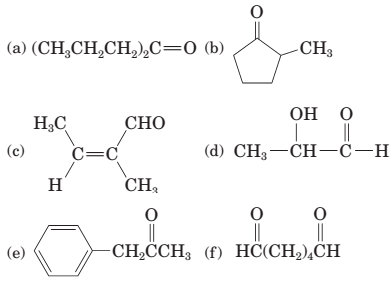
Interpretation:
The IUPAC names of the given compound should be determined.
Concept Introduction:
The group that contains carbonyl group which is attached to at least one hydrogen is said to be an aldehyde group, general representation of an aldehyde group is RCH=O or RCHO. Whereas the group that contains carbonyl group which is attached to two carbon atoms is said to be a ketone group, general representation of a ketone group is RCOR’.
In order to give the IUPAC name to the aldehyde group, the following steps are followed:
1. The parent (longest)alkane chain is identified.
2. The ending of the parent chain from alkane (-e) is changed to -al for an aldehyde group. The carbonyl group of an aldehyde appear at the end of the carbon chain so, the numbering start with carbon having aldehyde group.
3. Name should be written in alphabetical order and other substituents are shown by the number.
In order to give the IUPAC name to the ketone group, the following steps are followed:
1. The parent (longest)alkane chain is identified.
2. The ending of the parent chain from alkane (-e) is changed to -one for a ketone group.
3. The numbering is of the chain is done in such a way that carbonyl carbon gets the smaller number.
4. Name should be written in alphabetical order and other substituents are shown by the number.
Explanation of Solution
The given structure is:
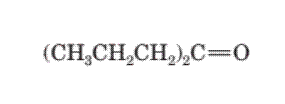
The parent chain in the given structure is heptane. Numbering is done in such a way that carbonyl carbon gets number 4.
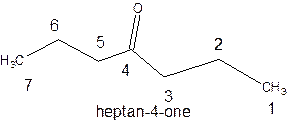
So, the IUPAC name will be: heptanes-4-one.
Interpretation:
The IUPAC names of the given compound should be determined.
Concept Introduction:
The group that contains carbonyl group which is attached to at least one hydrogen is said to be an aldehyde group, general representation of an aldehyde group is RCH=O or RCHO. Whereas the group that contains carbonyl group which is attached to two carbon atoms is said to be a ketone group, general representation of a ketone group is RCOR’.
In order to give the IUPAC name to the aldehyde group, the following steps are followed:
1. The parent (longest)alkane chain is identified.
2. The ending of the parent chain from alkane (-e) is changed to -al for an aldehyde group. The carbonyl group of an aldehyde appear at the end of the carbon chain so, the numbering start with carbon having aldehyde group.
3. Name should be written in alphabetical order and other substituents are shown by the number.
In order to give the IUPAC name to the ketone group, the following steps are followed:
1. The parent (longest) alkane chain is identified.
2. The ending of the parent chain from alkane (-e) is changed to -one for a ketone group.
3. The numbering is of the chain is done in such a way that carbonyl carbon gets the smaller number.
4. Name should be written in alphabetical order and other substituents are shown by the number.
Explanation of Solution
The given structure is:

The parent chain in the given structure is cyclopentane and methyl group is substituted at second carbon.

So, the IUPAC name will be: 2-methylcyclopentanone.
Interpretation:
The IUPAC names of the given compound should be determined.
Concept Introduction:
The group that contains carbonyl group which is attached to at least one hydrogen is said to be an aldehyde group, general representation of an aldehyde group is RCH=O or RCHO. Whereas the group that contains carbonyl group which is attached to two carbon atoms is said to be a ketone group, general representation of a ketone group is RCOR’.
In order to give the IUPAC name to the aldehyde group, the following steps are followed:
1. The parent (longest)alkane chain is identified.
2. The ending of the parent chain from alkane (-e) is changed to -al for an aldehyde group. The carbonyl group of an aldehyde appear at the end of the carbon chain so, the numbering start with carbon having aldehyde group.
3. Name should be written in alphabetical order and other substituents are shown by the number.
In order to give the IUPAC name to the ketone group, the following steps are followed:
1. The parent (longest)alkane chain is identified.
2. The ending of the parent chain from alkane (-e) is changed to -one for a ketone group.
3. The numbering is of the chain is done in such a way that carbonyl carbon gets the smaller number.
4. Name should be written in alphabetical order and other substituents are shown by the number.
Explanation of Solution
The given structure is:
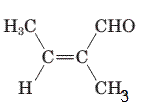
The parent chain in the given structure is butene. Numbering is done in such a way that aldehyde group gets smallest number.
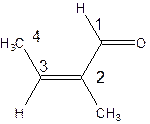
So, the IUPAC name will be: 2-methylbut-2-enal.
Interpretation:
The IUPAC names of the given compound should be determined.
Concept Introduction:
The group that contains carbonyl group which is attached to at least one hydrogen is said to be an aldehyde group, general representation of an aldehyde group is RCH=O or RCHO. Whereas the group that contains carbonyl group which is attached to two carbon atoms is said to be a ketone group, general representation of a ketone group is RCOR’.
In order to give the IUPAC name to the aldehyde group, the following steps are followed:
1. The parent (longest) alkane chain is identified.
2. The ending of the parent chain from alkane (-e) is changed to -al for an aldehyde group. The carbonyl group of an aldehyde appear at the end of the carbon chain so, the numbering start with carbon having aldehyde group.
3. Name should be written in alphabetical order and other substituents are shown by the number.
In order to give the IUPAC name to the ketone group, the following steps are followed:
1. The parent (longest)alkane chain is identified.
2. The ending of the parent chain from alkane (-e) is changed to -one for a ketone group.
3. The numbering is of the chain is done in such a way that carbonyl carbon gets the smaller number.
4. Name should be written in alphabetical order and other substituents are shown by the number.
Explanation of Solution
The given structure is:

The parent chain in the given structure is propane. Numbering is done in such a way that aldehyde group gets smallest number and −OH group on carbon number second will behave as substituent.

So, the IUPAC name will be: 2-hydroxypropanal.
Interpretation:
The IUPAC names of the given compound should be determined.
Concept Introduction:
The group that contains carbonyl group which is attached to at least one hydrogen is said to be an aldehyde group, general representation of an aldehyde group is RCH=O or RCHO. Whereas the group that contains carbonyl group which is attached to two carbon atoms is said to be a ketone group, general representation of a ketone group is RCOR’.
In order to give the IUPAC name to the aldehyde group, the following steps are followed:
1. The parent (longest) alkane chain is identified.
2. The ending of the parent chain from alkane (-e) is changed to -al for an aldehyde group. The carbonyl group of an aldehyde appear at the end of the carbon chain so, the numbering start with carbon having aldehyde group.
3. Name should be written in alphabetical order and other substituents are shown by the number.
In order to give the IUPAC name to the ketone group, the following steps are followed:
1. The parent (longest)alkane chain is identified.
2. The ending of the parent chain from alkane (-e) is changed to -one for a ketone group.
3. The numbering is of the chain is done in such a way that carbonyl carbon gets the smaller number.
4. Name should be written in alphabetical order and other substituents are shown by the number.
Explanation of Solution
The given structure is:

The parent chain in the given structure is propane. Numbering is done in such a way that ketone group gets smallest number and benzene ring on carbon number first will behave as substituent.
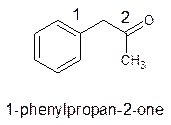
So, the IUPAC name will be: 1-phenylpropan-2-one.
Interpretation:
The IUPAC names of the given compound should be determined.
Concept Introduction:
The group that contains carbonyl group which is attached to at least one hydrogen is said to be an aldehyde group, general representation of an aldehyde group is RCH=O or RCHO. Whereas the group that contains carbonyl group which is attached to two carbon atoms is said to be a ketone group, general representation of a ketone group is RCOR’.
In order to give the IUPAC name to the aldehyde group, the following steps are followed:
1. The parent (longest) alkane chain is identified.
2. The ending of the parent chain from alkane (-e) is changed to -al for an aldehyde group. The carbonyl group of an aldehyde appear at the end of the carbon chain so, the numbering start with carbon having aldehyde group.
3. Name should be written in alphabetical order and other substituents are shown by the number.
In order to give the IUPAC name to the ketone group, the following steps are followed:
1. The parent (longest) alkane chain is identified.
2. The ending of the parent chain from alkane (-e) is changed to -one for a ketone group.
3. The numbering is of the chain is done in such a way that carbonyl carbon gets the smaller number.
4. Name should be written in alphabetical order and other substituents are shown by the number.
Explanation of Solution
The given structure is:

The parent chain in the given structure is hexane. Numbering is done in such a way that aldehyde group gets smallest number.
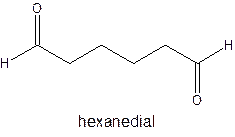
So, the IUPAC name will be: hexanedial.
Want to see more full solutions like this?
Chapter 16 Solutions
INTRO.TO GENERAL,ORGAN...-OWLV2 ACCESS
- For Raman spectroscopy/imaging, which statement is not true regarding its disadvantages? a) Limited spatial resolution. b) Short integration time. c) A one-dimensional technique. d) Weak signal, only 1 in 108 incident photons is Raman scattered. e) Fluorescence interference.arrow_forwardUsing a cell of known pathlength b = 1.25115 x 10-3 cm, a water absorption spectrum was measured. The band at 1645 cm-1, assigned to the O-H bending, showed an absorbance, A, of 1.40. a) Assuming that water density is 1.00 g/mL, calculate the water molar concentration c (hint: M= mole/L) b) Calculate the molar absorptivity, a, of the 1645 cm-1 band c) The transmitted light, I, can be written as I= Ioexp(-xb), where x is the absorption coefficient (sometimes designated as alpha), Io is the input light, and b is the cell pathlength. Prove that x= (ln10)*x*c. (Please provide a full derivation of the equation for x from the equation for I). d) Calculate x for the 1645 cm-1 bandarrow_forwardI need help with the follloaingarrow_forward
- For a CARS experiment on a Raman band 918 cm-1, if omega1= 1280 nm, calculate the omega2 in wavelength (nm) and the CARS output in wavelength (nm).arrow_forwardI need help with the following questionarrow_forwardFor CARS, which statement is not true regarding its advantages? a) Contrast signal based on vibrational characteristics, no need for fluorescent tagging. b) Stronger signals than spontaneous Raman. c) Suffers from fluorescence interference, because CARS signal is at high frequency. d) Faster, more efficient imaging for real-time analysis. e) Higher resolution than spontaneous Raman microscopy.arrow_forward
- Draw the major product of the Claisen condensation reaction between two molecules of this ester. Ignore inorganic byproducts. Incorrect, 5 attempts remaining 1. NaOCH3/CH3OH 2. Acidic workup Select to Draw O Incorrect, 5 attempts remaining The total number of carbons in the parent chain is incorrect. Review the reaction conditions including starting materials and/or intermediate structures and recount the number of carbon atoms in the parent chain of your structure. OKarrow_forwardUsing a cell of known pathlength b = 1.25115 x 10-3 cm, a water absorption spectrum was measured. The band at 1645 cm-1, assigned to the O-H bending, showed an absorbance, A, of 1.40. a) Assuming that water density is 1.00 g/mL, calculate the water molar concentration c (hint: M= mole/L) b) Calculate the molar absorptivity, a, of the 1645 cm-1 band c) The transmitted light, I, can be written as I= Ioexp(-xb), where x is the absorption coefficient (sometimes designated as alpha), Io is the input light, and b is the cell pathlength. Prove that x= (ln10)*x*c d) Calculate x for the 1645 cm-1 bandarrow_forwardConvert 1.38 eV into wavelength (nm) and wavenumber (cm-1) (c = 2.998 x 108 m/s; h = 6.626 x 10-34 J*s).arrow_forward
 Introduction to General, Organic and BiochemistryChemistryISBN:9781285869759Author:Frederick A. Bettelheim, William H. Brown, Mary K. Campbell, Shawn O. Farrell, Omar TorresPublisher:Cengage Learning
Introduction to General, Organic and BiochemistryChemistryISBN:9781285869759Author:Frederick A. Bettelheim, William H. Brown, Mary K. Campbell, Shawn O. Farrell, Omar TorresPublisher:Cengage Learning
 Organic And Biological ChemistryChemistryISBN:9781305081079Author:STOKER, H. Stephen (howard Stephen)Publisher:Cengage Learning,
Organic And Biological ChemistryChemistryISBN:9781305081079Author:STOKER, H. Stephen (howard Stephen)Publisher:Cengage Learning, General, Organic, and Biological ChemistryChemistryISBN:9781285853918Author:H. Stephen StokerPublisher:Cengage Learning
General, Organic, and Biological ChemistryChemistryISBN:9781285853918Author:H. Stephen StokerPublisher:Cengage Learning Chemistry for Today: General, Organic, and Bioche...ChemistryISBN:9781305960060Author:Spencer L. Seager, Michael R. Slabaugh, Maren S. HansenPublisher:Cengage Learning
Chemistry for Today: General, Organic, and Bioche...ChemistryISBN:9781305960060Author:Spencer L. Seager, Michael R. Slabaugh, Maren S. HansenPublisher:Cengage Learning




